2020专升本英语阅读理解答题技巧
【浙江专升本】浙江专升本英语考试阅读七大高分技巧

浙江专升本英语考试阅读七大高分技巧Ⅰ. 阅读理解方法阅读理解是综合读者各方面知识的过程。
要想快捷,准确的理解所阅读的语篇,我们要清具备什么样的能力,理解的过程,阅读的层次,阅读的目的,阅读技能等。
学会阅读意味着我们具备以下的能力:理解作者的思想和观点。
看出文章的叙事或推论过程。
看出并思考所读文章的细节,获的详细的信息。
把已获得的信息保在大脑中以便随时使用。
看出作者的主要意图和文章的基调。
从有关资料中汲取有用的东西。
对非重要情节或信息一带而过。
根据阅读目的和材料的难易程度调整阅读速度和方法。
根据作者的描述的出自己的结论。
掌握词的多种含义的知识。
另外,我们也想在此强调指出:我们不能盲目的应用快读“技巧”,而应该根据不同情况调整阅读速度。
如:对场景,人物性格,人物心理刻画要细读。
其中最重要的一点就是要知道在什么时候快读,什么时候慢读。
要提高阅读速度,正确的阅读方法是问题的关键。
1. 你是否善于阅读为了正确的评价自己的阅读能力,我们可以对照检验一下自己在阅读时是否有以下影响阅读效率的行为,但第2,3条,得在你不注意时,别人观察你。
你是否读的非常慢,非常仔细,不相信自己能全部理解所读的东西。
阅读时你的嘴唇和舌头是否在动。
在阅读时你的头是否随着所读文字的符号的位置而左右移动。
你是否经常回读,即,读过的东西又重新读一遍,甚至几遍。
你是否读什么样的体裁都是一样的速度。
你是否有很多单词不认识,或不知道他在此处的含义。
如果对上述的问题回答是肯定的,那你确实需要提高阅读技能。
如果只有一两项的回答是肯定的,那你就需要针对这一两种不良习惯寻找有效的解决方法,以帮住你提高阅读能力。
2.扩大词汇量有限的词汇量必然影响你的阅读能力提高。
生词的含义只有在上下文中才能完全展现出来,并易于被记住、理解、掌握。
换句话说,是上下文给一个词以特定的含义,而这个特定的含义往往是字典无法提供的。
不少教师鼓励学生背句子、段落、整片文章,都是出于同一目的,即:要学生在上下文中理解并掌握词汇和短语。
专升本英语阅读理解解题技巧和方法
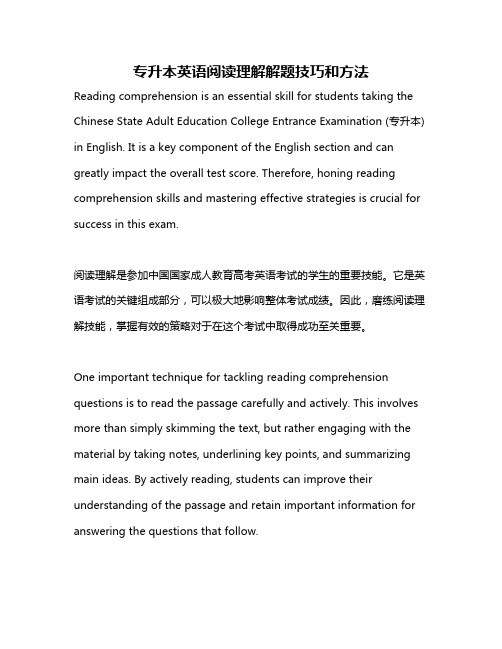
专升本英语阅读理解解题技巧和方法Reading comprehension is an essential skill for students taking the Chinese State Adult Education College Entrance Examination (专升本) in English. It is a key component of the English section and can greatly impact the overall test score. Therefore, honing reading comprehension skills and mastering effective strategies is crucial for success in this exam.阅读理解是参加中国国家成人教育高考英语考试的学生的重要技能。
它是英语考试的关键组成部分,可以极大地影响整体考试成绩。
因此,磨练阅读理解技能,掌握有效的策略对于在这个考试中取得成功至关重要。
One important technique for tackling reading comprehension questions is to read the passage carefully and actively. This involves more than simply skimming the text, but rather engaging with the material by taking notes, underlining key points, and summarizing main ideas. By actively reading, students can improve their understanding of the passage and retain important information for answering the questions that follow.处理阅读理解问题的一个重要技巧是仔细和主动地阅读文章。
专升本英语答题技巧及套路
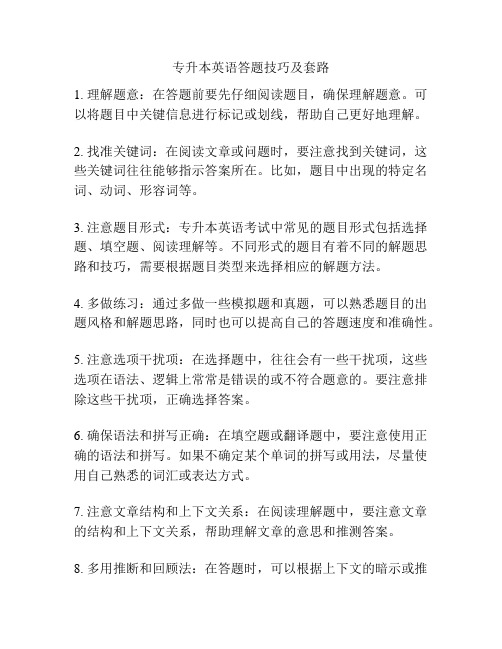
专升本英语答题技巧及套路
1. 理解题意:在答题前要先仔细阅读题目,确保理解题意。
可以将题目中关键信息进行标记或划线,帮助自己更好地理解。
2. 找准关键词:在阅读文章或问题时,要注意找到关键词,这些关键词往往能够指示答案所在。
比如,题目中出现的特定名词、动词、形容词等。
3. 注意题目形式:专升本英语考试中常见的题目形式包括选择题、填空题、阅读理解等。
不同形式的题目有着不同的解题思路和技巧,需要根据题目类型来选择相应的解题方法。
4. 多做练习:通过多做一些模拟题和真题,可以熟悉题目的出题风格和解题思路,同时也可以提高自己的答题速度和准确性。
5. 注意选项干扰项:在选择题中,往往会有一些干扰项,这些选项在语法、逻辑上常常是错误的或不符合题意的。
要注意排除这些干扰项,正确选择答案。
6. 确保语法和拼写正确:在填空题或翻译题中,要注意使用正确的语法和拼写。
如果不确定某个单词的拼写或用法,尽量使用自己熟悉的词汇或表达方式。
7. 注意文章结构和上下文关系:在阅读理解题中,要注意文章的结构和上下文关系,帮助理解文章的意思和推测答案。
8. 多用推断和回顾法:在答题时,可以根据上下文的暗示或推
断来选择答案。
同时,回顾已经做过的题目,可以避免答题过程中的疏忽和错误。
9. 控制答题时间:专升本英语考试中,时间往往是有限的。
在答题时要控制好答题的速度,尽量避免在某个题目上花费过多时间,影响其他题目的答题。
10. 多读英语文章和练习听力:阅读英语文章和练习听力,可以帮助提高理解能力和积累词汇量,这对于专升本英语考试中的阅读理解和听力部分有很大的帮助。
专升本英语阅读理解提分秘诀这里有4个技巧
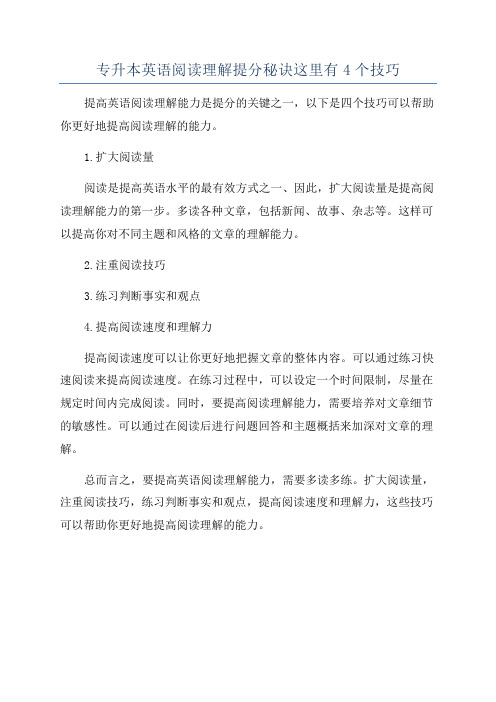
专升本英语阅读理解提分秘诀这里有4个技巧提高英语阅读理解能力是提分的关键之一,以下是四个技巧可以帮助你更好地提高阅读理解的能力。
1.扩大阅读量
阅读是提高英语水平的最有效方式之一、因此,扩大阅读量是提高阅读理解能力的第一步。
多读各种文章,包括新闻、故事、杂志等。
这样可以提高你对不同主题和风格的文章的理解能力。
2.注重阅读技巧
3.练习判断事实和观点
4.提高阅读速度和理解力
提高阅读速度可以让你更好地把握文章的整体内容。
可以通过练习快速阅读来提高阅读速度。
在练习过程中,可以设定一个时间限制,尽量在规定时间内完成阅读。
同时,要提高阅读理解能力,需要培养对文章细节的敏感性。
可以通过在阅读后进行问题回答和主题概括来加深对文章的理解。
总而言之,要提高英语阅读理解能力,需要多读多练。
扩大阅读量,注重阅读技巧,练习判断事实和观点,提高阅读速度和理解力,这些技巧可以帮助你更好地提高阅读理解的能力。
英语专升本答题技巧
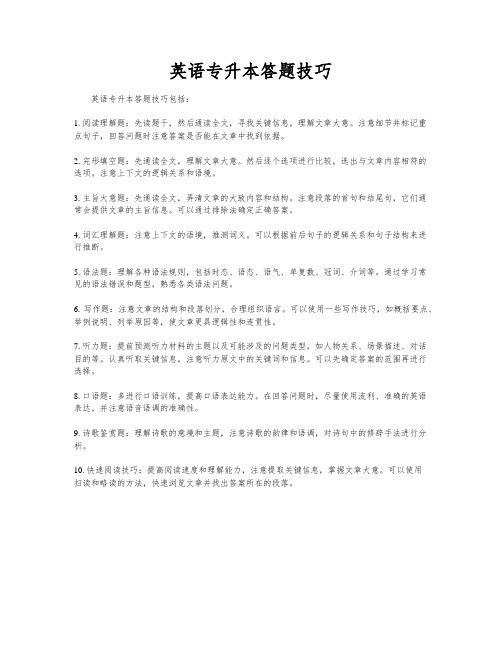
英语专升本答题技巧英语专升本答题技巧包括:1. 阅读理解题:先读题干,然后通读全文,寻找关键信息,理解文章大意。
注意细节并标记重点句子,回答问题时注意答案是否能在文章中找到依据。
2. 完形填空题:先通读全文,理解文章大意。
然后逐个选项进行比较,选出与文章内容相符的选项。
注意上下文的逻辑关系和语境。
3. 主旨大意题:先通读全文,弄清文章的大致内容和结构。
注意段落的首句和结尾句,它们通常会提供文章的主旨信息。
可以通过排除法确定正确答案。
4. 词汇理解题:注意上下文的语境,推测词义。
可以根据前后句子的逻辑关系和句子结构来进行推断。
5. 语法题:理解各种语法规则,包括时态、语态、语气、单复数、冠词、介词等。
通过学习常见的语法错误和题型,熟悉各类语法问题。
6. 写作题:注意文章的结构和段落划分,合理组织语言。
可以使用一些写作技巧,如概括要点、举例说明、列举原因等,使文章更具逻辑性和连贯性。
7. 听力题:提前预测听力材料的主题以及可能涉及的问题类型,如人物关系、场景描述、对话目的等。
认真听取关键信息,注意听力原文中的关键词和信息。
可以先确定答案的范围再进行选择。
8. 口语题:多进行口语训练,提高口语表达能力。
在回答问题时,尽量使用流利、准确的英语表达,并注意语音语调的准确性。
9. 诗歌鉴赏题:理解诗歌的意境和主题,注意诗歌的韵律和语调,对诗句中的修辞手法进行分析。
10. 快速阅读技巧:提高阅读速度和理解能力,注意提取关键信息,掌握文章大意。
可以使用扫读和略读的方法,快速浏览文章并找出答案所在的段落。
专升本中的外语题解题技巧
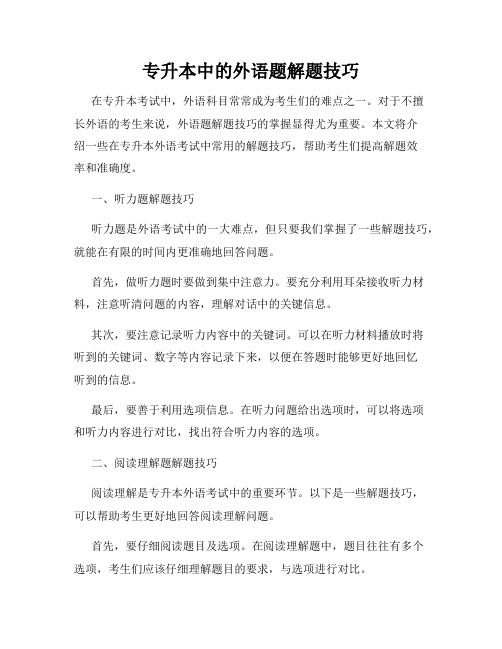
专升本中的外语题解题技巧在专升本考试中,外语科目常常成为考生们的难点之一。
对于不擅长外语的考生来说,外语题解题技巧的掌握显得尤为重要。
本文将介绍一些在专升本外语考试中常用的解题技巧,帮助考生们提高解题效率和准确度。
一、听力题解题技巧听力题是外语考试中的一大难点,但只要我们掌握了一些解题技巧,就能在有限的时间内更准确地回答问题。
首先,做听力题时要做到集中注意力。
要充分利用耳朵接收听力材料,注意听清问题的内容,理解对话中的关键信息。
其次,要注意记录听力内容中的关键词。
可以在听力材料播放时将听到的关键词、数字等内容记录下来,以便在答题时能够更好地回忆听到的信息。
最后,要善于利用选项信息。
在听力问题给出选项时,可以将选项和听力内容进行对比,找出符合听力内容的选项。
二、阅读理解题解题技巧阅读理解是专升本外语考试中的重要环节。
以下是一些解题技巧,可以帮助考生更好地回答阅读理解问题。
首先,要仔细阅读题目及选项。
在阅读理解题中,题目往往有多个选项,考生们应该仔细理解题目的要求,与选项进行对比。
其次,要注意文章的结构。
文章的结构往往可以帮助我们理解文章的逻辑关系和主旨意思,从而更好地回答问题。
最后,要善于运用排除法。
在选项中进行排除,找出与文章内容不符的选项,这样能够减少选择范围,提高答题准确性。
三、完型填空题解题技巧完型填空题是考察考生对语法和词汇掌握程度的重要题型。
以下是一些解题技巧,可以帮助考生更好地回答完型填空题。
首先,要通读全文。
在回答完型填空题前,我们应该通读全文,理解文章的大意和背景信息,这样才能更准确地选择答案。
其次,要注意上下文语境。
根据上下文的语境,我们可以推测出空格处需要填入什么类型的单词或短语,从而更好地选择和填入答案。
最后,要注意动词时态和语态的变化。
在完型填空题中,动词时态和语态的变化是非常常见的考点,我们应该注意根据上下文选择正确的动词形式。
综上所述,掌握一些解题技巧对于在专升本外语考试中取得好成绩来说是非常重要的。
山东专升本英语答题技巧
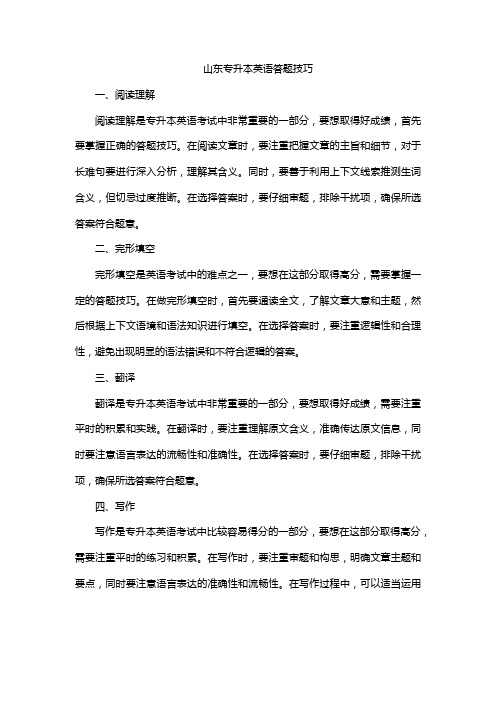
山东专升本英语答题技巧
一、阅读理解
阅读理解是专升本英语考试中非常重要的一部分,要想取得好成绩,首先要掌握正确的答题技巧。
在阅读文章时,要注重把握文章的主旨和细节,对于长难句要进行深入分析,理解其含义。
同时,要善于利用上下文线索推测生词含义,但切忌过度推断。
在选择答案时,要仔细审题,排除干扰项,确保所选答案符合题意。
二、完形填空
完形填空是英语考试中的难点之一,要想在这部分取得高分,需要掌握一定的答题技巧。
在做完形填空时,首先要通读全文,了解文章大意和主题,然后根据上下文语境和语法知识进行填空。
在选择答案时,要注重逻辑性和合理性,避免出现明显的语法错误和不符合逻辑的答案。
三、翻译
翻译是专升本英语考试中非常重要的一部分,要想取得好成绩,需要注重平时的积累和实践。
在翻译时,要注重理解原文含义,准确传达原文信息,同时要注意语言表达的流畅性和准确性。
在选择答案时,要仔细审题,排除干扰项,确保所选答案符合题意。
四、写作
写作是专升本英语考试中比较容易得分的一部分,要想在这部分取得高分,需要注重平时的练习和积累。
在写作时,要注重审题和构思,明确文章主题和要点,同时要注意语言表达的准确性和流畅性。
在写作过程中,可以适当运用
一些高级词汇和句型,提高文章质量。
在检查时,要注意语法和拼写错误,保持卷面整洁。
总之,要想在山东专升本英语考试中取得好成绩,需要注重平时的积累和实践,掌握正确的答题技巧。
通过不断的练习和总结经验教训,相信考生们一定能够取得优异的成绩。
专升本英语阅读理解技巧汇总

专升本英语阅读理解技巧汇总1、事实细节题这类题型一般有两个特征:一是直接理解性题目。
这种题目比较简单,只要通读全文,了解文中所叙述的重要事实或细节,就可以解答出来,有的甚至可以从文章的原句中直接找到答案;二是隐形题目,这要求对文中难词、关键词、词组或句子作出解释或需要对上下文提供的语境和信息,做出准确、立体的理解和判断。
常见的命题形式:①What is called "food miles" according to this passage?②Which of the following is true according to the passage?解题方法:读题干,明确题目问的是什么;定位。
带着问题读原文,找到题目出现的位置;根据语境和句子认真分析、推理,选出正确答案。
2、主旨大意题阅读理解是对整个文章的目的、意图、观点立场、态度以及内在的逻辑关系的理解,而不是断章取义,所以统览全篇的问题是很有必要的,这些问题会给你提供信息或暗示文章中的一些重要细节。
在统览全篇的同时要注意抓住文章的中心大意,捕捉主题句。
常见的命题形式①The main idea of this text may be...②This passage is mainly about...③The author's purpose in writing this text...④Which of the following is the best title for the passage?⑤What's the topic of the text?⑥The passage gives us is...解题方法:把握全段、文思想;留意,关注段首、段尾或位于段中的句子,捕捉主题句;不能断章取义,要在细读全文的基础上,结合背景知识、生活常识等推理、判断,从而获取文章中隐藏的信息。
3、猜测词义题这类问题主要考查学生根据上下文推测和判断生词、短语或句子在阅读材料中含义的能力。
专升本英语阅读理解答题技巧

专升本英语阅读理解答题技巧专升本英语阅读理解,那可真是不少小伙伴心中的“老大难”。
就像爬山,看着那高高的山峰,心里直犯嘀咕。
不过别怕,我这儿有不少小窍门呢。
做阅读理解,就像是去一个陌生的地方探险。
咱得先把地图看清了,也就是得先快速浏览一遍文章。
这浏览啊,可不是让你一个字一个字地精读,就像你去逛街,先大致看看这条街都有啥店铺一样。
你得知道这文章大概是讲啥的,是讲科技新发现呢,还是讲一段有趣的历史故事。
这时候你眼睛就像小雷达,扫过标题、开头、结尾还有每段的开头句。
这些地方就像是宝藏的线索,能让你对文章有个初步的印象。
那遇到生词咋办呢?生词就像是路上的小石子,偶尔会绊你一下。
但你不能被它绊倒就不走了呀。
有时候你可以根据上下文猜猜这个词的意思。
比如说,“The man is so stingy that he never buys his friends a drink.”你看,就算你不知道“stingy”这个词啥意思,但是后面说他从不给朋友买饮料,那你大概就能猜到这个词是形容人小气、吝啬的。
这就好比你看到一个人穿着厚厚的棉袄,戴着大棉帽,在大夏天里还直喊冷,你虽然不知道他到底怎么了,但你能猜到他可能是身体有点毛病,特别怕冷。
再来说说题目类型。
有些题目就像是找宝藏的直接指令,它会直接问你文章里的某个细节。
这时候你就得像个细心的侦探,回到文章里去找那个对应的地方。
比如说题目问你主人公是在哪一年发现那个神秘的岛屿的,那你就得回文章里去找到提到年份的地方。
这就像你妈让你找家里的钥匙,她告诉你就在客厅的桌子上,那你就直接去客厅桌子找就对了。
还有一种题目是让你推断作者的意图或者文章的主旨。
这就有点像猜谜语了。
你得把文章当成一个整体来看,就像看一幅大拼图,你不能只盯着一块小碎片。
你得把所有的线索都拼凑起来。
比如说一篇文章讲了环境污染的各种现象,然后又提到了一些环保的措施,虽然文章没有直接说,但你能推断出作者可能是想呼吁大家保护环境。
专升本英语技巧总结
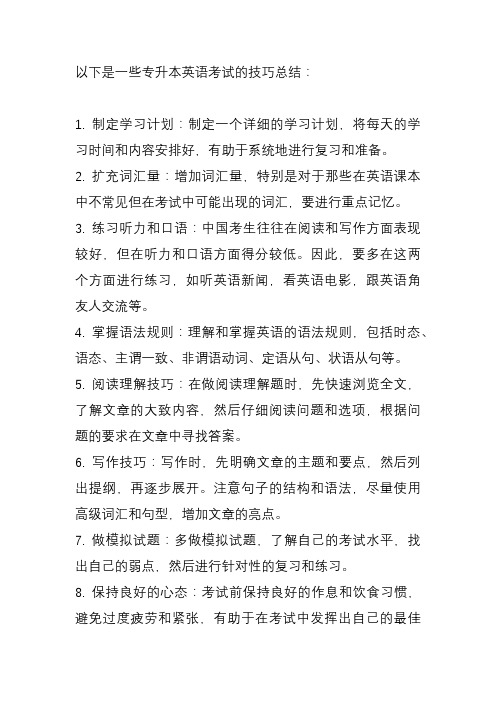
以下是一些专升本英语考试的技巧总结:
1. 制定学习计划:制定一个详细的学习计划,将每天的学习时间和内容安排好,有助于系统地进行复习和准备。
2. 扩充词汇量:增加词汇量,特别是对于那些在英语课本中不常见但在考试中可能出现的词汇,要进行重点记忆。
3. 练习听力和口语:中国考生往往在阅读和写作方面表现较好,但在听力和口语方面得分较低。
因此,要多在这两个方面进行练习,如听英语新闻,看英语电影,跟英语角友人交流等。
4. 掌握语法规则:理解和掌握英语的语法规则,包括时态、语态、主谓一致、非谓语动词、定语从句、状语从句等。
5. 阅读理解技巧:在做阅读理解题时,先快速浏览全文,了解文章的大致内容,然后仔细阅读问题和选项,根据问题的要求在文章中寻找答案。
6. 写作技巧:写作时,先明确文章的主题和要点,然后列出提纲,再逐步展开。
注意句子的结构和语法,尽量使用高级词汇和句型,增加文章的亮点。
7. 做模拟试题:多做模拟试题,了解自己的考试水平,找出自己的弱点,然后进行针对性的复习和练习。
8. 保持良好的心态:考试前保持良好的作息和饮食习惯,避免过度疲劳和紧张,有助于在考试中发挥出自己的最佳
水平。
这些只是一些基本的技巧和建议,具体的学习方法可能因人而异。
希望这些能对你有所帮助,祝你考试成功!。
专升本英语阅读理解知识点解析

专升本英语阅读理解知识点解析在专升本英语考试中,阅读理解是一个占据较大分值且具有一定难度的部分。
要想在这一板块取得较好的成绩,掌握相关的知识点是至关重要的。
下面,我们将对专升本英语阅读理解的知识点进行详细解析。
一、词汇量词汇是理解文章的基础。
拥有足够的词汇量能够帮助我们更快速、准确地理解文章的含义。
在准备专升本英语阅读理解时,需要重点掌握常见的高频词汇、短语以及一些特定领域的专业词汇。
我们可以通过多种方式来扩充词汇量,比如背诵单词书、阅读英文文章、利用手机 APP 进行学习等。
同时,要学会根据上下文猜测生词的意思,这在阅读理解中是一项非常实用的技能。
二、语法知识正确理解句子的语法结构对于阅读理解至关重要。
常见的语法点包括各种时态、语态、从句(如定语从句、宾语从句、状语从句等)、非谓语动词等。
例如,在一个复杂的长句中,如果我们能够清晰地分辨出从句和主句的结构,就能更好地理解句子的核心意思。
此外,掌握一些固定的语法搭配和句型,也有助于我们更快地理解文章。
三、阅读技巧1、快速浏览在阅读文章之前,先快速浏览题目和选项,了解问题的大致方向。
然后带着问题去阅读文章,这样可以更有针对性地寻找答案。
2、抓关键句文章中的首段、尾段以及每段的首句和尾句往往包含着重要的信息。
这些关键句能够帮助我们快速把握文章的主旨和段落大意。
3、略读和精读相结合对于一些不重要的细节可以略读,而对于与题目相关或者关键的内容则要进行精读,仔细分析和理解。
4、推理判断根据文章中的已知信息进行推理和判断,得出合理的结论。
但要注意不能过度推理,要以文章提供的内容为依据。
四、文章类型专升本英语阅读理解的文章类型多样,包括记叙文、说明文、议论文等。
记叙文通常讲述一个故事或者经历,需要我们关注事件的发展和人物的情感。
说明文主要是对某个事物或现象进行解释和说明,要抓住事物的特点、原理和用途等。
议论文则是表达作者的观点和看法,需要我们理解作者的论点、论据以及论证过程。
河南专升本公共英语阅读理解小技巧

河南专升本公共英语阅读理解小技巧全文共10篇示例,供读者参考篇1Hello everyone! Today I'm going to share some tips with you on how to improve your reading comprehension for the public English exam in Henan Province.1. Read actively: When you are reading a passage, don't just stare at the words. Try to understand the main idea and key points. Highlight important information and take notes if necessary.2. Practice skimming and scanning: Skimming means quickly reading through the passage to get the main idea. Scanning means looking for specific information or keywords in the text. These techniques can help you save time and find answers more efficiently.3. Pay attention to context clues: Sometimes, you may come across unfamiliar words in the passage. Try to guess the meaning based on the context. Look for clues in the surrounding sentences to help you understand the word better.4. Break down complex sentences: If a sentence is too long or complicated, try to break it down into smaller parts. Focus on one clause at a time and then piece them together to understand the complete sentence.5. Practice with past exam papers: The best way to prepare for the exam is to practice with past papers. This will help you become familiar with the format and types of questions commonly asked.Remember, practice makes perfect! Keep practicing your reading skills and you will see improvement. Good luck with your exam preparation!篇2Hey guys! Today, I want to share with you some little tips on how to improve your reading comprehension for the public English exam in Henan. It might sound a bit boring, but trust me, it's super important and can really help you boost your scores!First of all, when you're reading a passage, make sure to read the questions first. This way, you can focus on the main points and key information while you're reading the text. It will save you time and help you understand what you need to look out for.Secondly, try to skim through the passage before you start answering the questions. This will give you an idea of the main topic and structure of the text. Pay attention to headings, subheadings, and any bold or italicized words, as they often highlight important information.Next, when you're answering the questions, remember to refer back to the passage for evidence. Don't just rely on your memory or guesses. Look for specific details or quotes that support your answers and make sure you understand the context in which they are used.Also, be careful with tricky words or phrases that might have different meanings in different contexts. Try to figure out the meaning based on the surrounding words or look them up in a dictionary if you're not sure.Lastly, practice, practice, practice! The more you read and answer questions, the better you'll get at understanding the texts and picking out the right answers. You can try practicing with sample papers or online exercises to hone your skills.So there you have it, a few tips to help you ace the public English exam in Henan. Remember, reading comprehension is a skill that can be improved with practice, so keep working on it and you'll do great! Good luck!篇3Hey guys, have you ever heard of the Henan adult education entrance exam? It's like a big test for grown-ups who want to go back to school and learn new stuff. One part of the test is all about reading in English, and it can be kinda tricky. But don't worry, I've got some tips to help you do your best on the reading comprehension part of the exam.First off, when you're reading a passage, try to understand the main idea. What's the point the author is trying to make? Is it about history, science, or maybe a story? Pay attention to the title and the first and last paragraphs – they usually give you clues about what the passage is all about.Next, look for details in the passage that support the main idea. These could be facts, examples, or explanations that help you understand the topic better. Sometimes the details are hidden in the middle of the passage, so make sure you read carefully.Another thing to watch out for is the tone of the passage. Is the author happy, sad, excited, or maybe serious? The tone can give you a hint about how you should feel about the topic too.And finally, don't forget to check the questions before you start reading. This can help you focus on what you need to look for in the passage. Try to answer the questions in your own words before you look at the answer choices – this can help you avoid getting tricked by wrong answers.So there you have it, some tips to help you rock the reading comprehension part of the Henan adult education entrance exam. Just remember to practice reading and try your best – you got this! Good luck, my friends!篇4Hey guys! Today I want to share some tips with you about how to do better in reading comprehension for the Henan adult college entrance examination. Reading can be a bit tricky sometimes, so it's important to have some tricks up your sleeve to help you understand the text better.First of all, it's super important to read the questions before you start reading the passage. This way, you can get an idea of what to look for while you're reading. Pay special attention to the keywords in the questions, as they can help you focus on what's important in the text.Next, when you start reading the passage, make sure to read it carefully and slowly. Don't rush through it, take your time to understand the main ideas and details. If there are any words you don't understand, try to guess the meaning based on the context or look them up in a dictionary.It's also a good idea to underline or highlight important information while you're reading. This way, you can easily find it later when you need to answer the questions. Pay attention to details like dates, names, and numbers, as they might be crucial for answering the questions correctly.After you finish reading the passage, go back to the questions and try to answer them using the information you just read. Don't spend too much time on one question if you're feeling stuck, move on to the next one and come back to it later if you have time.Remember, practice makes perfect! The more you practice reading comprehension, the better you'll get at it. So don't give up, keep practicing and you'll improve over time.I hope these tips help you with your reading comprehension skills for the Henan adult college entrance examination. Good luck!篇5Hey guys! Today I'm going to share with you some tips on how to ace the public English reading comprehension section in the Henan adult examination for college entrance!First tip is to read the questions before reading the passage. This way, you will have an idea of what information to look for while reading.Second tip is to understand the main idea of the passage. Look for keywords that can help you identify the main idea, such as names, dates, and key events.Third tip is to pay attention to the details. Often the questions will ask for specific details from the passage, so make sure to read carefully and take note of important information.Fourth tip is to practice regularly. The more you practice reading and answering questions, the better you will get at it. You can find practice passages online or in textbooks.Lastly, don't rush. Take your time to read the passage and questions carefully, and make sure to double check your answers before submitting.Remember, practice makes perfect! Good luck with your reading comprehension skills and ace that Henan adult examination!篇6Hey guys! Do you want to know some tips and tricks for reading comprehension in the public English exam for the Henan adult higher education entrance exam? Well, you're in luck because I've got some awesome tips for you!First off, when you're reading a passage, make sure to read the questions first. This way, you'll know what to look for as you read the passage. It will help you to focus on the important information and answer the questions more quickly.Next, don't get bogged down by words you don't know. If you come across a word you're not familiar with, try to figure out its meaning based on the context. If you still can't figure it out, skip over it and keep reading. You can always come back to it later if you need to.Another tip is to pay attention to key words and phrases in the questions. Sometimes the answer can be found in the question itself or in the options provided. By focusing on thesekey words, you'll be able to find the relevant information in the passage more easily.Lastly, practice, practice, practice! The more you practice reading comprehension, the better you'll get at it. Try reading different kinds of passages and answering different types of questions to improve your skills.So there you have it, some handy tips for tackling the reading comprehension section of the public English exam. Good luck with your studies and remember, practice makes perfect!篇7Hey guys! Today I want to share some tips and tricks for reading comprehension in the public English exam for the adult education in Henan! Let's get started!1. Read the questions first: Before you even start reading the passage, take a quick look at the questions. This will help you focus on the important information as you read.2. Skim the passage: Don't try to read every single word in the passage. Skim through it quickly to get an idea of the main points and key information.3. Look for keywords: When you're reading the questions and the passage, pay attention to keywords that are repeated or stand out. These can help you find the answers more quickly.4. Take notes: If you come across important information while reading, jot it down in the margins or on a separate sheet of paper. This will help you remember and refer back to it later.5. Use context clues: If you come across a word you don't know, try to figure out its meaning based on the surrounding sentences or paragraphs.6. Eliminate wrong answers: When you're not sure about an answer, eliminate the ones that you know are definitely wrong. This will increase your chances of getting it right.7. Practice, practice, practice: The more you practice reading comprehension, the better you'll get at it. Try doing some practice tests or reading passages from different sources.So there you have it, guys! With these tips and a little practice, you'll be acing the public English exam in no time. Good luck!篇8Hey guys, today I'm gonna share some tips with you on how to do well in reading comprehension in the Henan university entrance exam. I know reading can be boring, but trust me, these tips will help you ace the test!First of all, when you're reading the passage, don't try to understand every single word. Just focus on the main ideas and the overall meaning. This will save you time and help you answer the questions more effectively.Secondly, pay attention to key words in the questions such as "why", "how", "according to the passage", etc. These words will give you clues on where to find the answers in the passage.Also, try to predict the answer before looking at the options. This will help you stay focused and avoid getting distracted by wrong answers.Don't forget to go back to the passage to confirm your answers. Double-checking your answers can help you avoid silly mistakes.Lastly, practice, practice, practice! The more you practice reading comprehension, the better you will get at it. You can try reading English articles, newspapers, or even books to improve your reading skills.So there you have it, some tips to help you succeed in the reading comprehension section of the Henan university entrance exam. Good luck, guys!篇9Hey guys, do you want to know some tips for reading comprehension in the public English exam for the advanced studies in Henan province? Well, I've got you covered! Here are some super easy and fun tips that will help you ace the reading section:1. Read the questions first: Before you even start reading the passage, take a quick look at the questions. This will help you focus on what information you need to find while reading.2. Skim the passage: Don't get bogged down by trying to understand every single word. Skim through the passage quickly to get a general idea of what it's about.3. Pay attention to keywords: Look out for words that are repeated or stand out in the passage. These can help you locate the answers to the questions.4. Use context clues: If you come across a word you don't know, try to use the context of the sentence to figure out its meaning.5. Take your time: Don't rush through the passage. Take your time to read carefully and make sure you understand the main ideas.6. Practice, practice, practice: The more you practice reading comprehension, the better you'll get at it. Try doing some practice tests and exercises to improve your skills.Remember, reading comprehension is all about understanding the main ideas and details of a passage. So, follow these tips and you'll be on your way to acing the public English exam in Henan province. Good luck!篇10Hey guys! Do you want to know some cool tips for reading comprehension in the Henan Higher Vocational College English exam? Well, you're in luck because I've got some awesome tips to share with you!First things first, when you're reading the passage, make sure to read the questions first. This way, you'll know what to look for while you're reading and you can save time later on.Next, don't just focus on the words you don't know. Try to understand the main idea of the passage by looking for keywords and key phrases. These will help you grasp the overall meaning of the text.If you come across a word you don't know, try to figure out its meaning from the context. Look at the words around it and see if you can infer what it might mean.Another tip is to pay attention to the structure of the passage. Is it a narrative, a description, an argument? Understanding the structure can help you locate information more easily.And finally, don't panic if you don't know the answer to a question. Use the process of elimination to narrow down your options and make an educated guess.So there you have it, some handy tips for acing the reading comprehension section of the Henan Higher Vocational College English exam. Good luck, guys!。
湖北专升本英语阅读理解解题技巧
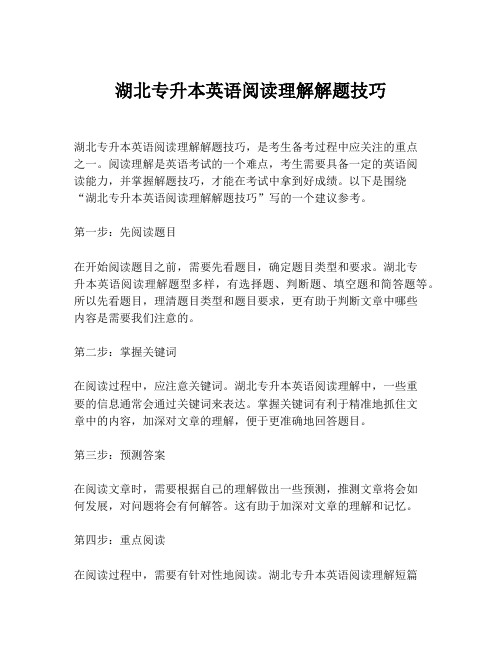
湖北专升本英语阅读理解解题技巧湖北专升本英语阅读理解解题技巧,是考生备考过程中应关注的重点之一。
阅读理解是英语考试的一个难点,考生需要具备一定的英语阅读能力,并掌握解题技巧,才能在考试中拿到好成绩。
以下是围绕“湖北专升本英语阅读理解解题技巧”写的一个建议参考。
第一步:先阅读题目在开始阅读题目之前,需要先看题目,确定题目类型和要求。
湖北专升本英语阅读理解题型多样,有选择题、判断题、填空题和简答题等。
所以先看题目,理清题目类型和题目要求,更有助于判断文章中哪些内容是需要我们注意的。
第二步:掌握关键词在阅读过程中,应注意关键词。
湖北专升本英语阅读理解中,一些重要的信息通常会通过关键词来表达。
掌握关键词有利于精准地抓住文章中的内容,加深对文章的理解,便于更准确地回答题目。
第三步:预测答案在阅读文章时,需要根据自己的理解做出一些预测,推测文章将会如何发展,对问题将会有何解答。
这有助于加深对文章的理解和记忆。
第四步:重点阅读在阅读过程中,需要有针对性地阅读。
湖北专升本英语阅读理解短篇文章,尤其需要注意关键句和重要信息的提取。
重点阅读可以帮助考生更快地理解文章,提高解题效率。
第五步:灵活运用答案技巧在答题过程中,需要结合实际情况和题目要求,选择不同的答案技巧。
例如,在进行填空题时,需要根据句子中的语法、上下文等方面来确认填空单词的性质和形式。
总之,湖北专升本英语阅读理解解题技巧需要考生具备一定的英语基础和阅读能力,更需要耐心和细心,注重细节,多加练习,灵活应用不同的答题技巧和方法,才能在考试中获得更好的成绩。
英语阅读理解题7个实用答题技巧

英语阅读理解题7个实用答题技巧阅读理解是英语考试中重要的一部分,掌握有效的答题技巧可以帮助我们提高阅读理解的得分。
以下是七个实用的答题技巧:1. 预览题目和选项:在阅读文章之前,先浏览一遍题目和选项,这样可以帮助我们有一个初步的了解。
预览题目可以帮助我们确定重要信息,同时也可以帮助我们获取文章的主旨和结构。
2. 理解文章结构:阅读理解文章通常有一个明确的结构,包括引言、主体和结尾。
通过理解文章的结构,可以帮助我们更好地理解文章的意思和作者的观点。
3. 注意关键词:在阅读文章时,要注意关键词和关键短语。
关键词通常可以给我们提示文章的重要信息和主题。
4. 理解上下文:阅读理解题中常常会出现一些词汇或句子,需要通过上下文来理解其含义。
在遇到生词或难句时,可以通过上下文来推测其意思。
5. 多次阅读:多次阅读可以帮助我们更好地理解文章的内容。
第一次阅读可以帮助我们获取整体的理解,第二次阅读可以帮助我们更深入地理解细节。
6. 利用排除法:如果在选择题中有一些选项不符合文章的意思或不合乎逻辑,可以通过排除法来选择正确答案。
排除法可以帮助我们缩小选项的范围,提高答题的准确性。
7. 注意时间分配:在考试中,时间是有限的,因此要合理分配阅读和答题的时间。
可以根据题目的难易程度和分值来决定花费的时间。
通过掌握这七个实用的答题技巧,我们可以在英语阅读理解中取得更好的成绩。
总结:1. 预览题目和选项2. 理解文章结构3. 注意关键词4. 理解上下文5. 多次阅读6. 利用排除法7. 注意时间分配希望这些技巧对你有帮助!祝你考试顺利!。
专升本英语阅读理解题技巧和方法

专升本英语阅读理解题技巧和方法When it comes to tackling the reading comprehension section of the English proficiency test for adult higher education, there are several key techniques and methodsthat can help improve your performance.First and foremost, it is essential to develop strong skimming and scanning skills. Skimming involves quickly reading through the passage to get a general idea of the main points and overall structure, while scanning involves looking for specific details or information. These skills are crucial for efficiently locating the relevantinformation needed to answer the questions within the given time frame.Another important technique is to actively engage withthe text while reading. This means making mental notes of key ideas, concepts, and arguments presented in the passage. It can also involve underlining or highlighting important information to aid in later reference. By doing so, you can improve your understanding of the material and retain important details that will be useful when answering the questions.Furthermore, it is beneficial to familiarize yourself with different question types commonly found in reading comprehension tests. These can include identifying main ideas, understanding supporting details, making inferences, and analyzing the author's tone or purpose. By practicing with a variety of question types, you can become more adept at recognizing the specific skills required to answer each type of question.Additionally, it is advisable to expand your vocabulary and improve your reading speed. A strong vocabulary will enable you to comprehend a wider range of texts, while increased reading speed will allow you to cover more material within the allotted time. Both of these factors can significantly enhance your performance in the reading comprehension section.In summary, developing strong skimming and scanning skills, actively engaging with the text, familiarizing yourself with different question types, expanding your vocabulary, and improving your reading speed are all essential techniques and methods for excelling in theEnglish reading comprehension section of the adult higher education proficiency test.中文翻译:在应对成人高等教育英语水平考试的阅读理解部分时,有几种关键技巧和方法可以帮助提高你的表现。
2020年河南专升本公共英语高分答题技巧!

一、单项选择题这一道题主要是考察基础知识。
在答题的过程中,需要注意的问题是一定要能够联想起相关的语法问题。
这种题型是送分题,大部分学生都有能力得满分。
同学们失分的原因主要是不够关注细节,考虑问题不够全面。
做这种题型时一定要考虑时态和语态的问题,主谓一致的问题,相关的固定词组和固定搭配的问题。
二、完形填空完型填空题,是同学们感到困惑最多的一道题。
它从多个角度命题,涉及的知识点较多,考查的范围也很广,要想完成好这道题必须从这几方面入手。
1.通读全文,领悟大意。
完型填空常以文章或段落的形式出现,因此,通读全文,把握文章整体大意就尤为重要。
很多同学为了省时间或其他原因,只看选项,不看文章。
不看上下文,不寻找文章中句子与句子的关系,结果做出来的答案往往是错误的。
2.联系上下文,前后要贯通。
完型填空经常对连词进行设题。
因为,连词的使用为各句之间提供了紧密的因果、转折、并列等内在逻辑关系。
通过发现和正确地运用连词,可以从宏观的角度把握文章的大意,构建全文的内在逻辑结构,领会作者意图,获得正确的信息,找出正确的答案。
3.仔细推敲、反复核对。
在做完此题后,最好把所有答案填回原文中,然后将弥补完整的全文从头至尾看一遍,以确保文章上下文顺畅连贯、语法准确、逻辑合理。
根据这个原则,某一个空格所对应的答案很可能就是在上下文中复现或同现的相关词,我们可以根据这些动词之间的有机联系,确定答案。
三、阅读理解1.先看题干,带着问题读文章。
答题前,要仔细通读全文,遇到不懂的生词、词组和句子不要急躁,跳过去,尽量根据上下文悟出其意。
阅读题干,首先要掌握问题的类型,分清是客观信息题还是主观判断题。
其次,了解试题题干以及各个选项所包含的信息,然后有针对性地对文章进行扫读,对有关信息进行快速定位,再将相关信息进行整合、甄别、分析、对比,有根有据地排除干扰项,选出正确答案。
2.速读全文,了解大意知主题。
阅读的目的是获取信息。
一个人的阅读能力的高低决定了他能否快速高效吸收有用信息。
专升本【英语】考试【阅读理解】猜词技巧
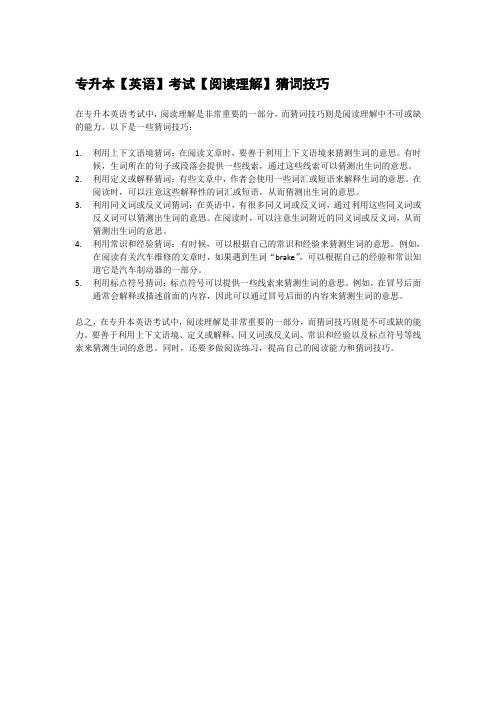
专升本【英语】考试【阅读理解】猜词技巧
在专升本英语考试中,阅读理解是非常重要的一部分,而猜词技巧则是阅读理解中不可或缺的能力。
以下是一些猜词技巧:
1.利用上下文语境猜词:在阅读文章时,要善于利用上下文语境来猜测生词的意思。
有时
候,生词所在的句子或段落会提供一些线索,通过这些线索可以猜测出生词的意思。
2.利用定义或解释猜词:有些文章中,作者会使用一些词汇或短语来解释生词的意思。
在
阅读时,可以注意这些解释性的词汇或短语,从而猜测出生词的意思。
3.利用同义词或反义词猜词:在英语中,有很多同义词或反义词,通过利用这些同义词或
反义词可以猜测出生词的意思。
在阅读时,可以注意生词附近的同义词或反义词,从而猜测出生词的意思。
4.利用常识和经验猜词:有时候,可以根据自己的常识和经验来猜测生词的意思。
例如,
在阅读有关汽车维修的文章时,如果遇到生词“brake”,可以根据自己的经验和常识知道它是汽车制动器的一部分。
5.利用标点符号猜词:标点符号可以提供一些线索来猜测生词的意思。
例如,在冒号后面
通常会解释或描述前面的内容,因此可以通过冒号后面的内容来猜测生词的意思。
总之,在专升本英语考试中,阅读理解是非常重要的一部分,而猜词技巧则是不可或缺的能力。
要善于利用上下文语境、定义或解释、同义词或反义词、常识和经验以及标点符号等线索来猜测生词的意思。
同时,还要多做阅读练习,提高自己的阅读能力和猜词技巧。
专升本英语阅读理解提分秘诀,这里有4个技巧

专升本英语阅读理解提分秘诀,这里有4个技巧英语是专升本必考科目,也是拉分科目。
而英语考试中阅读理解分值占40%,可以说阅读能够拿高分,英语整体分数自然就上去了。
英语阅读理解需要大量刷题。
但是题也不能白刷,还要掌握解题技巧,分析答题思路。
01阅读丢分原因①单词量不够,无法理解文章的全部内容。
②答题无章法、无技巧,造成前面耗时过多,后面为了追速度,草草阅读,出错率高。
02阅读题答题技巧这类题在设题时常会用到title, subject, main idea, topic, theme等词。
1.归纳标题特点:短小精悍,一般多为一个短语;涵盖性强,一般能覆盖全文意思;精确性强,表达范围要恰当,不能随意改变语意程度或色彩。
常见命题形式有:What’s the best title for the text?The best title for this passage is ___.Which of the following can be the best title for the passage?2. 概括大意题包括寻找段落大意(topic)和文章中心思想(main idea),常见命题形式有:What is the general/main idea of the passage?Which of the following expresses the main idea?What is the subject discussed in the text?The writer of the story wants to tell us that_____.The passage/ text is mainly about_____.What’s the article mainly about ?3. 解题技巧阅读理解文章多是议论文和说明文,这两种文体的结构可归纳为:提出问题——论述问题——得出结论或者阐明观点。
- 1、下载文档前请自行甄别文档内容的完整性,平台不提供额外的编辑、内容补充、找答案等附加服务。
- 2、"仅部分预览"的文档,不可在线预览部分如存在完整性等问题,可反馈申请退款(可完整预览的文档不适用该条件!)。
- 3、如文档侵犯您的权益,请联系客服反馈,我们会尽快为您处理(人工客服工作时间:9:00-18:30)。
2020专升本英语阅读理解答题技巧主旨大意题这类题在设题时常会用到title, subject, main idea, topic, theme等词。
1.归纳标题特点:短小精悍,一般多为一个短语;涵盖性强,一般能覆盖全文意思;精确性强,表达范围要恰当,不能随意改变语意水准或色彩。
常见命题形式有:What’s the best title for thetext?The best title for this passage is ___.Which of the following can be the best title for the passage?2. 概括大意题包括寻找段落大意(topic)和文章中心思想(main idea),常见命题形式有:What is the general/main idea of the passage?Which of the following expresses the main idea?What is the subject discussed in the text?The writer of the story wants to tell us that_____.The passage/ text is mainlyabout_____.What’s the article mainly about ?3. 解题技巧阅读理解文章多是议论文和说明文,这两种文体的结构可归纳为:提出问题——论述问题——得出结论或者阐明观点。
对于这类文章,抓主题句是快速掌握文章大意的主要方法。
主题句一般出现在文章的开头或结尾。
主题句具有简洁性、概括性的特点。
细节理解题考查内容主要涉即时间、地点、人物、事件、原因、结果、数字等议论文中例证细节和定义类细节。
这类题目的共同特点是:答案一般都能在文章中找到。
1.事实细节题→寻读法分为直接理解题和间接理解题,前者常用who, what, which, when, where, why和how提问,或判断正误;后者需与原文信息转换,表达上与原文有差异。
常见命题形式有:What can we learn from the passage?All the following are mentioned except?Which of the following is mentioned (not mentioned)?Which of the following statements istrue/right/false/w rong about…?2. 排列顺序题→首尾定位法(找出第一个事件和最后一个事件,用排除法缩小范围)常出现在记叙文和说明文中,一般按事件发生的顺序。
常见命题形式有:Which of the following is the correct order of…?Which of the following shows the path of signals described in Paragraph…?3. 图文匹配题→按图索骥理清线索设题形式:给出图表,根据图表提问问题。
4. 数字计算题→(方法:审题→带着问题找细节→对比、分析、计算)可直接找到相关细节,但需经过计算方可找到答案。
推理判断题主要考查学生对文章中隐含或深层的含意的理解水平。
它要求考生根据文章内容做出合乎逻辑的推断,包括考生对作者观点的理解,态度的判断,对修辞、语气、隐含意思等的理解。
题干关键词:infer(推断),indicate(象征,暗示), imply/suggest(暗示), conclude(作出结论), assume(假定,设想)。
1.细节推理判断题一般可根据短文提供的信息或借助生活常识实行推理判断,常见命题形式有:It can be inferred/ concluded from the text that __________.The author implies/ suggests that_____.We may infer that _________.Which of the following statements is implied but NOT stated?2.预测推理判断题根据语篇对文章接下来的内容或可能的结局实行猜测,常见命题形式有:What do you think will happenif/when…?At the end of this passage, the writer might continue to write_____3.推测文章来源或读者对象常见命题形式有:The passage is probably take out of_____The passage would most likely be found in_____Where does this text probably come from?4.写作意图、目的、态度推断题询问写作目的的题,选项里常出现的词是:explain(解释), prove (证明), persuade(劝说), advise(劝告), comment(评论), praise(赞扬), criticize(批评), entertain(娱乐), demonstrate(举例说明), argue(辩论), tell(讲述), analyze(分析)等。
询问语气态度的题,选项里常出现的词是:neutral(中立的), sympathetic(同情的), satisfied(满意的), friendly(友好的), enthusiastic(热情的), subjective(主观的), objective(客观的), matter-of-fact(实事求是的), pessimistic(悲观的),optimistic(乐观的), critical(批评的), doubtful(怀疑的), hostile(敌对的), indifferent(冷淡的), disappointed(失望的)。
常见命题形式有:The purpose of the text is_____What is the main purpose of the author writing the text? By mentioning…, the author aims to show that_____What is theauthor’s attitude towards…?What is the author’s opinion on…?The author’s tone in this passage is _____.解答技巧推断题是考查学生透过文章表面的文字信息实行分析、综合、归纳等逻辑推理的水平。
推理和判断必须以事实为依据,切莫主观臆断。
①那些文章中直接陈述的内容不能选,要选择根据文章推理出来的选项。
②推理不是凭空猜测,而是立足已知推断未知;作出准确答案时一定要在文中找到依据或理由。
③要忠实于原文,以文章提供的事实和线索为依据。
不能以自己的观点代替作者的想法;不要脱离原文主观臆断。
词义猜测题考点:①猜测某个词、词组、句子的意义②对文中的多义词或词组实行定义③判断某个代词的指代的对象。
常见命题形式有:The underlined word/phrase in the second paragraph means_____.The word “it/they” in the last sentence refersto______.The word “…”(Line 6. para.2)probably means______.The word “…”(Line 6. para.2)could best be replacedby which of the following?Which of the following is closestin meaning to the word “…”?解答技巧1.通过因果关系猜词首先是找出生词与上下文之间的逻辑关系,然后才能猜词。
有时文章借助关联词(如because,as,since,for,so,thus,as a result,of course等等)表示前因后果。
例如:You shouldn't have blamed him for that,for itwasn't his fault.通过for引出的句子所表示的原因(那不是他的错),可猜出blame的词义是"责备"。
2.通过同义词和反义词的关系猜词通过同义词猜词,一是要看由and或or连接的同义词词组,如happy and gay,即使我们不理解gay 这个词,也能够知道它是愉快的意思;二是看在进一步解释的过程中使用的同义词,如Man has known something about the planets Venus,Mars,and Jupiter with the help of spaceships.此句中的Venus(金星)、Mars(火星)、Jupiter(木星)均为生词,但只要知道planets就可猜出这几个词都属于"行星"这个义域。
通过反义词猜词,一是看表转折关系的连词或副词,如but,while,however等;二是看与not搭配的或表示否定意义的词语,如:He is so homely,not at all as handsome as his brother.根据not at all...handsome我们不难推测出homely的意思,即不英俊、不漂亮的意思。
3.通过构词法猜词根据前缀、后缀、复合、派生等构词知识判断生词词义。
如:She is unlikely to have stolen the money.( “un”含否定意义,故为“不太可能”之意。
)4.通过定义或释义关系来推测词义例如:But sometimes,norain falls for a long,long time. Then there is a dry period,or drought. 从drought所在句子的上文我们得知很久不下雨,于是便有一段干旱的时期,即drought,由此可见drought意思为"久旱","旱灾"。
而a dry period和drought是同义语。
这种同义或释义关系常由is,or,that is,in other words,be called或破折号等来表示。
5.通过句法功能来推测词义例如:Bananas,oranges,pineapples,coconuts and some other kind of fruit grow inwarm areas.假如pineapples和coconuts是生词,我们能够从这两个词在句中所处的位置来判断它们大致的意思。
